Thibaut Vidal
Fairness and Sparsity within Rashomon sets: Enumeration-Free Exploration and Characterization
Feb 07, 2025



Abstract:We introduce an enumeration-free method based on mathematical programming to precisely characterize various properties such as fairness or sparsity within the set of "good models", known as Rashomon set. This approach is generically applicable to any hypothesis class, provided that a mathematical formulation of the model learning task exists. It offers a structured framework to define the notion of business necessity and evaluate how fairness can be improved or degraded towards a specific protected group, while remaining within the Rashomon set and maintaining any desired sparsity level. We apply our approach to two hypothesis classes: scoring systems and decision diagrams, leveraging recent mathematical programming formulations for training such models. As seen in our experiments, the method comprehensively and certifiably quantifies trade-offs between predictive performance, sparsity, and fairness. We observe that a wide range of fairness values are attainable, ranging from highly favorable to significantly unfavorable for a protected group, while staying within less than 1% of the best possible training accuracy for the hypothesis class. Additionally, we observe that sparsity constraints limit these trade-offs and may disproportionately harm specific subgroups. As we evidenced, thoroughly characterizing the tensions between these key aspects is critical for an informed and accountable selection of models.
From Counterfactuals to Trees: Competitive Analysis of Model Extraction Attacks
Feb 07, 2025Abstract:The advent of Machine Learning as a Service (MLaaS) has heightened the trade-off between model explainability and security. In particular, explainability techniques, such as counterfactual explanations, inadvertently increase the risk of model extraction attacks, enabling unauthorized replication of proprietary models. In this paper, we formalize and characterize the risks and inherent complexity of model reconstruction, focusing on the "oracle'' queries required for faithfully inferring the underlying prediction function. We present the first formal analysis of model extraction attacks through the lens of competitive analysis, establishing a foundational framework to evaluate their efficiency. Focusing on models based on additive decision trees (e.g., decision trees, gradient boosting, and random forests), we introduce novel reconstruction algorithms that achieve provably perfect fidelity while demonstrating strong anytime performance. Our framework provides theoretical bounds on the query complexity for extracting tree-based model, offering new insights into the security vulnerabilities of their deployment.
Training Set Reconstruction from Differentially Private Forests: How Effective is DP?
Feb 07, 2025



Abstract:Recent research has shown that machine learning models are vulnerable to privacy attacks targeting their training data. Differential privacy (DP) has become a widely adopted countermeasure, as it offers rigorous privacy protections. In this paper, we introduce a reconstruction attack targeting state-of-the-art $\varepsilon$-DP random forests. By leveraging a constraint programming model that incorporates knowledge of the forest's structure and DP mechanism characteristics, our approach formally reconstructs the most likely dataset that could have produced a given forest. Through extensive computational experiments, we examine the interplay between model utility, privacy guarantees, and reconstruction accuracy across various configurations. Our results reveal that random forests trained with meaningful DP guarantees can still leak substantial portions of their training data. Specifically, while DP reduces the success of reconstruction attacks, the only forests fully robust to our attack exhibit predictive performance no better than a constant classifier. Building on these insights, we provide practical recommendations for the construction of DP random forests that are more resilient to reconstruction attacks and maintain non-trivial predictive performance.
DistrictNet: Decision-aware learning for geographical districting
Dec 11, 2024Abstract:Districting is a complex combinatorial problem that consists in partitioning a geographical area into small districts. In logistics, it is a major strategic decision determining operating costs for several years. Solving districting problems using traditional methods is intractable even for small geographical areas and existing heuristics often provide sub-optimal results. We present a structured learning approach to find high-quality solutions to real-world districting problems in a few minutes. It is based on integrating a combinatorial optimization layer, the capacitated minimum spanning tree problem, into a graph neural network architecture. To train this pipeline in a decision-aware fashion, we show how to construct target solutions embedded in a suitable space and learn from target solutions. Experiments show that our approach outperforms existing methods as it can significantly reduce costs on real-world cities.
Free Lunch in the Forest: Functionally-Identical Pruning of Boosted Tree Ensembles
Aug 28, 2024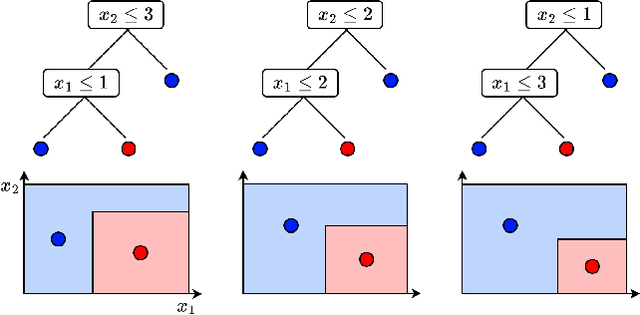
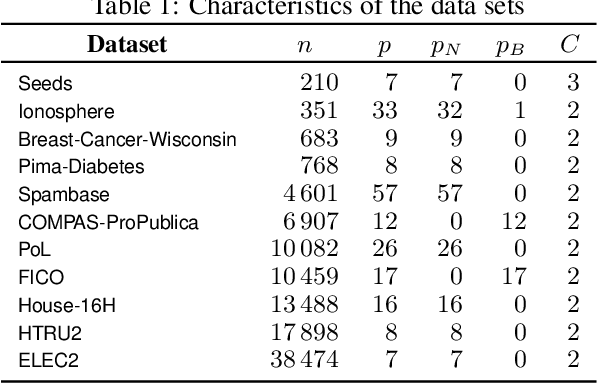
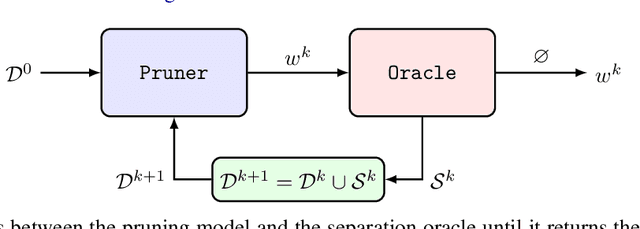
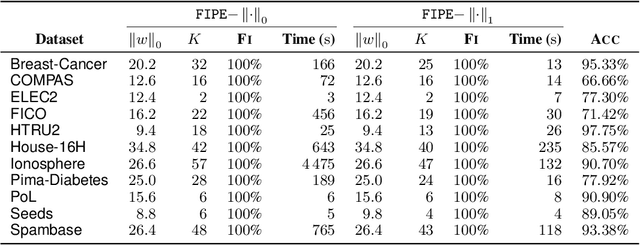
Abstract:Tree ensembles, including boosting methods, are highly effective and widely used for tabular data. However, large ensembles lack interpretability and require longer inference times. We introduce a method to prune a tree ensemble into a reduced version that is "functionally identical" to the original model. In other words, our method guarantees that the prediction function stays unchanged for any possible input. As a consequence, this pruning algorithm is lossless for any aggregated metric. We formalize the problem of functionally identical pruning on ensembles, introduce an exact optimization model, and provide a fast yet highly effective method to prune large ensembles. Our algorithm iteratively prunes considering a finite set of points, which is incrementally augmented using an adversarial model. In multiple computational experiments, we show that our approach is a "free lunch", significantly reducing the ensemble size without altering the model's behavior. Thus, we can preserve state-of-the-art performance at a fraction of the original model's size.
Dual Policy Reinforcement Learning for Real-time Rebalancing in Bike-sharing Systems
Jun 02, 2024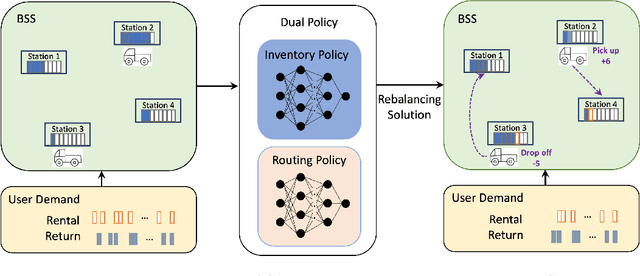
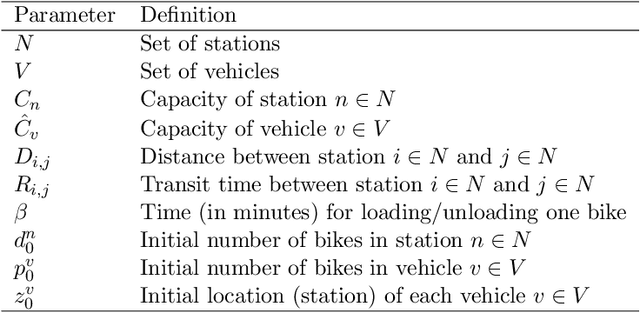
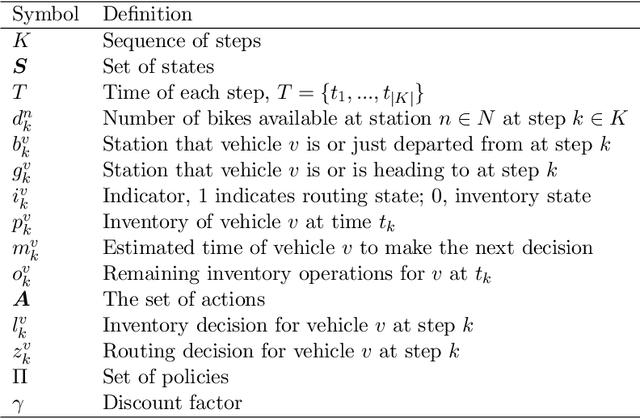

Abstract:Bike-sharing systems play a crucial role in easing traffic congestion and promoting healthier lifestyles. However, ensuring their reliability and user acceptance requires effective strategies for rebalancing bikes. This study introduces a novel approach to address the real-time rebalancing problem with a fleet of vehicles. It employs a dual policy reinforcement learning algorithm that decouples inventory and routing decisions, enhancing realism and efficiency compared to previous methods where both decisions were made simultaneously. We first formulate the inventory and routing subproblems as a multi-agent Markov Decision Process within a continuous time framework. Subsequently, we propose a DQN-based dual policy framework to jointly estimate the value functions, minimizing the lost demand. To facilitate learning, a comprehensive simulator is applied to operate under a first-arrive-first-serve rule, which enables the computation of immediate rewards across diverse demand scenarios. We conduct extensive experiments on various datasets generated from historical real-world data, affected by both temporal and weather factors. Our proposed algorithm demonstrates significant performance improvements over previous baseline methods. It offers valuable practical insights for operators and further explores the incorporation of reinforcement learning into real-world dynamic programming problems, paving the way for more intelligent and robust urban mobility solutions.
CF-OPT: Counterfactual Explanations for Structured Prediction
May 28, 2024



Abstract:Optimization layers in deep neural networks have enjoyed a growing popularity in structured learning, improving the state of the art on a variety of applications. Yet, these pipelines lack interpretability since they are made of two opaque layers: a highly non-linear prediction model, such as a deep neural network, and an optimization layer, which is typically a complex black-box solver. Our goal is to improve the transparency of such methods by providing counterfactual explanations. We build upon variational autoencoders a principled way of obtaining counterfactuals: working in the latent space leads to a natural notion of plausibility of explanations. We finally introduce a variant of the classic loss for VAE training that improves their performance in our specific structured context. These provide the foundations of CF-OPT, a first-order optimization algorithm that can find counterfactual explanations for a broad class of structured learning architectures. Our numerical results show that both close and plausible explanations can be obtained for problems from the recent literature.
Trained Random Forests Completely Reveal your Dataset
Feb 29, 2024



Abstract:We introduce an optimization-based reconstruction attack capable of completely or near-completely reconstructing a dataset utilized for training a random forest. Notably, our approach relies solely on information readily available in commonly used libraries such as scikit-learn. To achieve this, we formulate the reconstruction problem as a combinatorial problem under a maximum likelihood objective. We demonstrate that this problem is NP-hard, though solvable at scale using constraint programming -- an approach rooted in constraint propagation and solution-domain reduction. Through an extensive computational investigation, we demonstrate that random forests trained without bootstrap aggregation but with feature randomization are susceptible to a complete reconstruction. This holds true even with a small number of trees. Even with bootstrap aggregation, the majority of the data can also be reconstructed. These findings underscore a critical vulnerability inherent in widely adopted ensemble methods, warranting attention and mitigation. Although the potential for such reconstruction attacks has been discussed in privacy research, our study provides clear empirical evidence of their practicability.
Contextual Stochastic Vehicle Routing with Time Windows
Feb 10, 2024

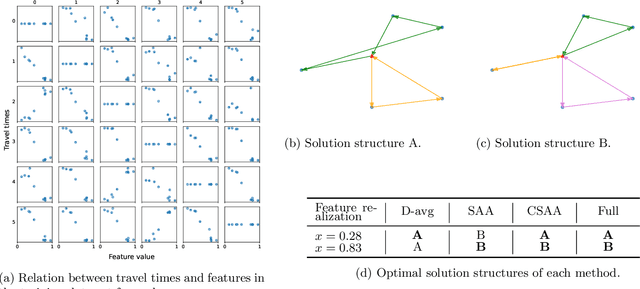
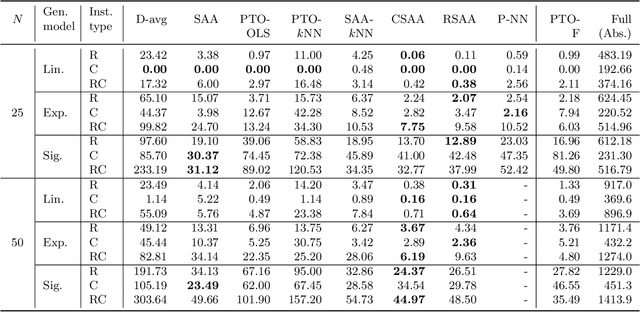
Abstract:We study the vehicle routing problem with time windows (VRPTW) and stochastic travel times, in which the decision-maker observes related contextual information, represented as feature variables, before making routing decisions. Despite the extensive literature on stochastic VRPs, the integration of feature variables has received limited attention in this context. We introduce the contextual stochastic VRPTW, which minimizes the total transportation cost and expected late arrival penalties conditioned on the observed features. Since the joint distribution of travel times and features is unknown, we present novel data-driven prescriptive models that use historical data to provide an approximate solution to the problem. We distinguish the prescriptive models between point-based approximation, sample average approximation, and penalty-based approximation, each taking a different perspective on dealing with stochastic travel times and features. We develop specialized branch-price-and-cut algorithms to solve these data-driven prescriptive models. In our computational experiments, we compare the out-of-sample cost performance of different methods on instances with up to one hundred customers. Our results show that, surprisingly, a feature-dependent sample average approximation outperforms existing and novel methods in most settings.
A Survey of Contextual Optimization Methods for Decision Making under Uncertainty
Jun 17, 2023
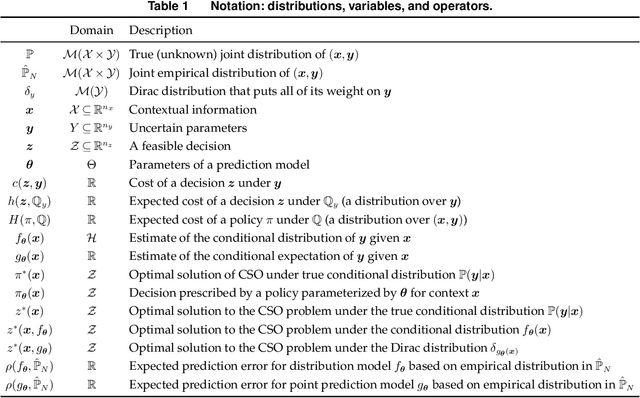


Abstract:Recently there has been a surge of interest in operations research (OR) and the machine learning (ML) community in combining prediction algorithms and optimization techniques to solve decision-making problems in the face of uncertainty. This gave rise to the field of contextual optimization, under which data-driven procedures are developed to prescribe actions to the decision-maker that make the best use of the most recently updated information. A large variety of models and methods have been presented in both OR and ML literature under a variety of names, including data-driven optimization, prescriptive optimization, predictive stochastic programming, policy optimization, (smart) predict/estimate-then-optimize, decision-focused learning, (task-based) end-to-end learning/forecasting/optimization, etc. Focusing on single and two-stage stochastic programming problems, this review article identifies three main frameworks for learning policies from data and discusses their strengths and limitations. We present the existing models and methods under a uniform notation and terminology and classify them according to the three main frameworks identified. Our objective with this survey is to both strengthen the general understanding of this active field of research and stimulate further theoretical and algorithmic advancements in integrating ML and stochastic programming.
 Add to Chrome
Add to Chrome Add to Firefox
Add to Firefox Add to Edge
Add to Edge